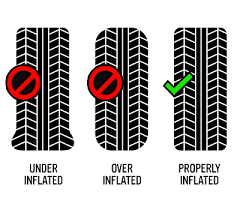Tires, the mostly black-coloured and round-shaped rubber components that encase the wheels of a car, giving the wheels and the car the main contact with the ground are very essential to the smooth, safe and optimal operation of almost every automobile.
To achieve this optimal operation, they are mostly filled with air to provide the pneumatic properties that allow air be the cushion between the base of the wheel and the contact patch of the tires thus providing a flexible cushion that absorbs shock as the tire rolls over any surface be it rough or smooth. Tires provide a footprint, called a contact patch, designed to match the vehicle’s weight. More importantly, the contact patch provides the traction needed to keep the tires secure on the road and on their intended path both in wet and dry conditions.

For an optimal operation, every tire has defined operating specifications that they should abide by and among them are the major ones viz; overinflation and underinflation.
Overinflation refers to when the air inside the tire is more than the recommended specification.
While underinflation is simply the opposite hence it is when the air inside the tire is (much) less than the recommended specification.
It is pertinent to point out that these recommended specifications differ from car to car, application of the car to another, and other factors.
And to show how important this information is for the car’s safe and proper use, the tire specification and pressure ratings are mostly printed on a visible sticker and pasted on the B-pillar or door of the car so that it is easy to be seen.
For a long time, many car drivers assumed that overinflation is the major cause of tire blow out. Unfortunately, the reverse is the case as underinflation is the silent major culprit.
Most modern tires can withstand enormous amount of air pressure inside them even above their recommended specification when overinflated but will very quickly degrade or suffer badly when driven while underinflated and easily lead to nasty consequences (car crashes) that can also turn fatal.
But it is very pertinent to also advise that overinflation also should be avoided as it also can lead to a tire blow out.
Some other factors that can lead to a tire blow out are bad roads, low quality tires, dangerous items littering the roads and overloading.
SOME MAJOR CAUSES OF UNDERINFLATION
1. Neglect: Infrequent tire pressure checks.
2. Lack of awareness: Unfamiliarity with recommended tire pressure.
3. Temperature changes: Tire pressure decreases with cold temperatures.
4. Tire damage: Leaks, wear, cuts or punctures can cause underinflation.
5. Overloading of the vehicle: This causes the tires to buckle under the excessive weight in the car that also affects the sidewalls of the tires.
CONSEQUENCES OF UNDERINFLATION
1. Increased risk of tire blowouts: Underinflated tires can overheat, leading to a blowout. This mostly happens because the reduced air content (pressure) of the tire means the sidewall become more flexible than desired thus rubbing against each other and even against the ground, compromising its structural integrity and increasing the heat inside the tire. Soon, this leads to thread separation on the sidewall thus creating weak areas that will be easy to succumb to the heated air inside the tire seeking for an avenue to escape.
2. Reduced traction: Underinflated tires can lead to reduced grip on the road, increasing stopping distances.
3. Poor handling: Underinflated tires can cause vehicles to pull to one side or vibrate while driving.
4. Fuel efficiency and tire wear: Underinflated tires can decrease fuel efficiency and lead to uneven tire wear.
5. Under-inflated tires have less ability to channel water away from the tire surface, increasing the likelihood of hydroplaning during wet conditions. A study published in the Journal of Transportation Safety & Security (Smith, 2021) found that tires with lower pressure are more susceptible to losing traction on wet roads.
PREVENTION AND SOLUTIONS
1. Regular tire pressure checks: Check tire pressure at least once a month, and before long trips.
2. Use the recommended tire pressure: Find the recommended tire pressure in your vehicle’s owner’s manual or on the tire information placard.
3. Maintain proper tire condition: Regularly inspect tires for signs of damage, wear, or underinflation.
4. Consider investing in a tire pressure monitoring system (TPMS): A TPMS can alert you to underinflation and help prevent tire-related accidents.
STATISTICS AND FACTS
1. According to the National Highway Traffic Safety Administration (NHTSA), underinflated tires contribute to over 600 fatalities and 33,000 injuries annually in the United States.
2. The American Automobile Association (AAA) estimates that properly inflated tires can improve fuel efficiency by up to 3%.
3. In Nigeria, the Federal Road Safety Corps (FRSC) said 772 out of the 9000 Road Traffic Accidents (RTCs) recorded in 2015 across the country were caused by burst tyres. The FRSC Head of Operations, Mr Adei Abu, disclosed this in Dutse at a road safety stakeholders’ campaign on good use of tyres.
By raising awareness about the dangers of underinflation and promoting regular tire maintenance, we can reduce the risk of tire-related accidents and save lives.

